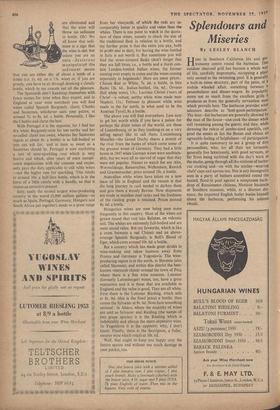I iv Other than French and German
By T. A. LAYTON
RED, white or rose, chilled or chambre, weak R or strong, young or old, blended or vintage, with a snack or a banquet, wine can claim to be the most civilised, sustaining, all-purpose beverage a man can have from youth to old age.
Some people think that it is primarily the soil, climate and geographical locality that bring about the making of a great or even fair wine. They are wrong, though. What happens is that once a certain district becomes vinously popular other growers crowd in, the area grows larger, competition produces better wines and so, over the centuries, there is built up a tradition and glamour.
Naturally, if a district has been making good wine for half a thousand years one tends to give nature all the credit, but scratch deeper and it becomes clear that man makes the wine and nature makes the grapes. And even that isn't true any more because, firstly, nearly all of the wines you drink in England 'come from European vines grafted on to American root stocks to stop a little louse, the Phylloxera, eating them; and, secondly, a vast amount of cross-breeding of grape species is going on so that a species can be selected for districts where our forefathers would have thought wine-making impossible.
Proof of 'all this can be seen if one surveys the wines available' for English gullets from the time of Edward III to Edward VII. First, it was Rochelle that was all the rage; yet there is no wine made there today. Then, Canary in Shake- speare's time; and in Queen Anne's, Tent, Moun- tain and Bucellas.
Around the time of George IV they made a wine just outside Perpignan, in the South of France, Masdeu (a corruption of 'God's Field') which was sufficiently popular in England for enamel or silver-plated neck labels to have been made for it. Where is it today? Where is Maslas, a dry special kind of Hungarian wine? Where, too, is Tokay? Oh yes! You can, if you look around, procure a little, but you won't find it available on every list as you would have done before the First World War. In other words, since none of the geographical features of these lost vineyards has changed one iota, we must take it that it is economic factors which have caused them to disappear. And just as vineyard areas can die away, so can new dis- tricts spring up in a few score of years where excellent wines can be made. So let us take a survey of some table wines available in England today, other than from those two colossi, France and Germany.
Indicative of the strides that Spain has made in her vinification methods is the fact that British Railways -(always one of the best buyers of wine in the country) 'are now putting discreet little cards on the tables of their dining cars regretting that French wines have had to go up, and offer- ing travellers a selection of table wines from Spain.
The best Spanish table wines come from a vast, unlovely plain which lies south of Bilbao —called the Rioja, a composite word formed from Rio and Oja, the river which flows through the best vineyards. The centre of the trade is the little town of Haro, as ugly 'as it is busy and as flourishing as it is hot. On the roof of the town hall is a carefully constructed nest for a visiting stork, and in the bodegas (overground wine ware- houses) are thousand upon thousand of gallons of , well-made, well-matured, cheap but good red wine.
The wine stays much longer in cask here than it does in France; maybe for traditional reasons, maybe because there is the available storage space and that the owners are not so pressed for cash. Anyway, the result is that mellow wines are pro- duced with the two added advantages that all chances of a secondary fermentation in bottle are eliminated and that the wine will throw no sediment in bottle. Oh ! We all know that sedi- ment is a sign that the wine is old, but unless you are an extra - dexterous manipulatot this sediment means that you are either shy of about a tenth of a bottle (i.e. Is. 6d. on a 15s. wine) or, if you are greedy, you have to sit through drinking a cloudy bottle, which to me cancels out all the pleasure.
The Spaniards don't handicap themselves with fancy names for wine when they export, and in England at your wine merchant you will find wines called Spanish Burgundy, claret, Chablis and Sauternes, whichever suits your palate, at around 7s. to 8s. 6d. a bottle. Personally, I like the Chablis and claret the best.
With Portugal it is the opposite, for I find her dry white Burgundy-style far too earthy and her so-called claret too sweet, whereas her Sauternes (again at about 8s. a bottle) is as full-bodied as you can -ask for, and in taste as sweet as a Sauternes should be. Portugal is now marketing a sort of semi-sparkling rosé which is very festive and which, after years of most compli- cated negotiations with the customs and excise, only pays the duty applicable to still table wines —not the higher rate for sparkling. This retails at around 10s. a half-litre bottle, which is in the form of a little carafe with a handle, so that it makes an attractive present.
Italy, easily the second largest wine-producing country in the world (1,000 million gallons—as much as Spain, Portugal, Germany, Hungary and South Africa put together), sends us a great range
from her vineyards, of which the reds are in- comparably better in quality and value than the whites. There is one point to watch in the quota- tion of these wines, namely to check the size of the traditional flask in relation to a bottle, and
my further point is that the extra you pay, both in profit and in duty, for having the wine bottled in Italy is not worth it. But sometimes you will find the straw-covered flasks (don't forget that they are full litres, i.e., a bottle and a third) con- tain London-bottled Italian wines, the former coming over empty in crates and the wines coming separately in hogsheads! Here are some prices : Chianti Red or White, 7s. 6d. a bottle, in litre flasks 12s. 6d., Italian-bottled, 16s. 6d.; Orvieto (full white wine), 13s.; Lacrima Christi ('tears of Christ'—a robust, earthy white wine made near Naples), I Is.; Terlaner (a pleasant white wine made in the far north, in what used to be the Austrian Tyrol), 8s. a bottle.
The above you will find everywhere. Less easy to get but worth while if you have a palate for perhaps the driest wines of the world, are those of Luxembourg, or as they (cashing-in on a very selling name) like to call them, Luxembourg Moselles—the Grand Duchy shares a stretch of the river from the banks of which come some of the greatest wines of Germany. They had a little boom in 1947 when German wines were unobtain- able, but we were all so starved of sugar that they were not popular. Names to watch for are Ahn, Wormeldange, Remerschen, Wellenstein, Remich and Gravenmacher, price around 10s. a bottle.
Australian white wines have taken on a new lease of life in England and the reason is that the long journey in cask tended to darken them and give them a woody flavour. Now shipments are made in stainless steel tanks and the freshness of the riesling grape is retained. Prices around 8s. 6d. a bottle.
Hungarian wines are now being seen more frequently in this country. Most of the wines are grown round that vast lake Balaton, on volcanic soil. The whites are extremely full-bodied and are most sound value. But my favourite, which is like a cross between a red Chianti and an above- average Spanish Burgundy, is Bull's Blood of Eger, which costs around 10s. 6d. a bottle.
But a country which has rtiade great strides in wine-making and taken business away from France and Germany is Yugoslavia. The wine- producing region is in the north, in Slovenia (also called Slavonia), and within this district the best- known vineyards cluster around the town of Ptuj, where there is a fine wine museum. Lutomer (formerly Luttenberger) wines, too, have a great reputation and it is these that are available in England and the value is good. They are all white. First there is the Lutomer Riesling, which sells at 8s. 9d. (this is the fixed 'price) a bottle; then comes the Sylvaner at 9s. 6d. Note here something unusual: in Alsace, where the majority of wines are sold as Sylvaner and Riesling (the names of two grape species) it is the Riesling which is indubitably and always the more expensive wine. In Yugoslavia it is the opposite; why, I don't know. Finally, there is the Sauvignon, a fuller, sweeter wine which retails at 10s. 6d.
Well, that ought to keep you happy over the festive season and without too much damage to your pocket, too.











































































 Previous page
Previous page